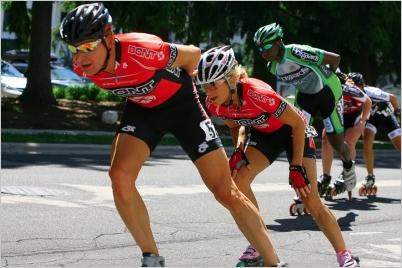This week's tip:
Pacelines and Aerodynamics
The path of least resistance in the paceline
By Debbie Rice

Debbie Rice drafting behind Bont teammate Norm Kirby.
Photo: Bont USA
When it comes to saving energy, two skaters are better than one. That’s because two skaters can form a paceline and draft each other to harness the power of aerodynamics.
Essentially, the lead skater cuts through the wind, decreasing the air resistance for the next skater.
This is a big deal. Aerodynamic drag is the largest force working against skaters, aside from the gravity of a large hill. And the energy savings of drafting can be substantial — as much as 40 percent, depending on the circumstances and conditions.
To better understand this, think of the air as a fluid that follows the laws of motion and fluid mechanics. When you are in another skater’s draft, you are essentially sucked along in his or her slipstream.
To stay in the slipstream, you must stay very close to the skater in front of you. In a headwind, you must be within inches. In fact, you should be so close that your chin could rest on the skater’s lower back.
But the best place is not always directly behind the skater in front of you. If the wind is coming from the side, you should be just behind and slightly to the opposite (leeward) side of the skater.
For example, if the wind is coming from the left, you should position yourself a little to the right. The trick is to find the path of least resistance.
Drafting and racing
Drafting is one of the most important tactics of inline racing, especially in marathons where skaters need to maintain top speed for more than an hour.
Teams often rotate their skaters in and out of the lead position to save energy during marathons. Then, at the end of the race, one team member typically performs a “lead out.”
The lead-out skater sacrifices himself or herself by taking the lead before the finish and breaking the wind for another team member.
When the lead-out skater tires, the drafting skater jumps out and sprints for the line.
It is a very effective strategy, used not only by skaters, but cyclists.
Fast apparel
Yes, what you wear matters. Loose clothes — like t-shirts and baggy shorts — catch the wind and slow you down, which can increase drag by as much as 30 percent.
Serious racers wear skinsuits made of Spandex or other form-fitting fabrics. The wind flows around these fabrics, cutting drag.
Paceline position
Where you are in a paceline also matters.
Pacelines can include as few as two and as many as 50 or more skaters. The best spot to be is usually in the middle or toward the front of the line.
The back is often trouble. Pacelines expand and contract like accordions, and this speeding up and slowing down is especially prominent in the back. So if you are back there, you are regularly having to sprint to keep up with the surges. Eventually, this can wear you out.
Another problem with being in the back is that you are more prone to getting tripped up by someone falling in front of you.
Size does matter
Bigger skaters provide a better draft. That’s because a larger object creates a larger “stagnation point” — basically a slipstream.
I know as a woman, I always enjoy races that allow cross drafting (women drafting men and vice versa) for the simple reason that men are generally larger and so can provide a bigger draft.
Bottom line: drafting can get you to the finish line quicker and help you — and your team — become a winner.
...
 Debbie Rice skated quads before inlines and became a master of both. On inlines, she has won numerous marathons, indoor championships and National Roller Cup titles. She also holds the Guinness record for fastest woman on skates — 61 mph. A former cast member of the Roller Jam television series, she now jams for the Bont's Quadstar Derby Team. She is a Bont sales representative and team manager of Bont USA and Bont Quadstars Derby Team. A Houston native, she currently lives in Tampa.
Debbie Rice skated quads before inlines and became a master of both. On inlines, she has won numerous marathons, indoor championships and National Roller Cup titles. She also holds the Guinness record for fastest woman on skates — 61 mph. A former cast member of the Roller Jam television series, she now jams for the Bont's Quadstar Derby Team. She is a Bont sales representative and team manager of Bont USA and Bont Quadstars Derby Team. A Houston native, she currently lives in Tampa.